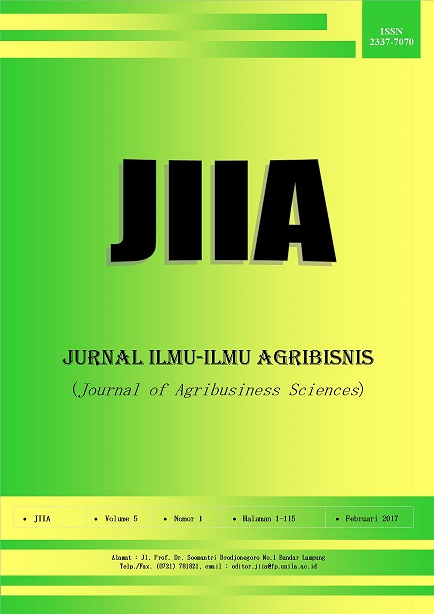SIKAP DAN KEPUASAN KONSUMEN RUMAH MAKAN AYAM PENYET HANG DIHI BANDAR LAMPUNG
DOI:
https://doi.org/10.23960/jiia.v5i1.1680 Abstract View: 1029
Abstract View: 1029
Abstract
The aims of this research are to analyze: customer’s characteristics, attitudes and satisfactions, and its correlation on the total of monthly customers’ purchase. The research location was determined purposively. The number of interviewed respondents was 60. Data were analyzed descriptively and by Multiatribute Fishbein, Customer Satisfaction Index (CSI) and Importance Performance Analysis (IPA), Pearson and rank Spearman correlation analysis. The research results showed that the customers of Hang Dihi restaurant were women, 16-25 years old, mostly college students followed by graduates with income or allowance of Rp1,000,000-Rp2,000,000 per month having 4-5 family members. They came to the restaurant location from 3-5 km distance, and purchased pressed fried chicken as much as Rp22,000–Rp31,000 per month. The value of customers’ attitude was 11.82 meaning that customers had positive attitudes. The CSI value was 72 percent; it meant that customers were satisfied overall. Based on IPA, the customers evaluated that hygiene, variations of menu, and cleanness of place were needed to be improved. There was correlation between the total purchase of pressed fried chicken at Hang Dihi and customers characteristics i.e. gender, education, job, income, and attitude and satisfaction.
Key words: attitude, CSI, IPA, pressed fried chicken, and satisfaction
Downloads
Downloads
Published
How to Cite
Issue
Section
License
Authors who publish with this journal agree to the following terms:
Authors retain copyright and grant the journal right of first publication with the work simultaneously licensed under a Creative Commons Attribution License that allows others to share the work with an acknowledgement of the work's authorship and initial publication in this journal.
Authors are able to enter into separate, additional contractual arrangements for the non-exclusive distribution of the journal's published version of the work (e.g., post it to an institutional repository or publish it in a book), with an acknowledgement of its initial publication in this journal.
Authors are permitted and encouraged to post their work online (e.g., in institutional repositories or on their website) prior to and during the submission process, as it can lead to productive exchanges, as well as earlier and greater citation of published work (See The Effect of Open Access).














